
Stagville Plantation is located in Durham County, North Carolina. With buildings constructed from the late 18th century to the mid-19th century, Stagville was part of one of the largest plantation complexes in the American South. The entire complex was owned by the Bennehan, Mantack and Cameron families; it comprised roughly 30,000 acres (120 km2) and was home to almost 900 enslaved African Americans in 1860.

Carr Mill Mall is a small, local shopping mall located in Carrboro, North Carolina. It is listed on the National Register of Historic Places as the Alberta Mill Complex. It is also a host for numerous local live performances and other cultural events.
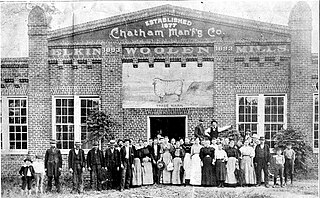
Chatham Manufacturing Mill was built by the Chatham Manufacturing Company. The former textile mill is located in Winston-Salem North Carolina.

Carolina is a village that straddles the border of the towns of Charlestown and Richmond on the Pawcatuck River in Washington County, Rhode Island. Rhode Island Route 112 passes through the village. Carolina is identified as a census-designated place, with a population of 970 at the 2010 census.

Durfee Mills is an historic textile mill complex located at 359-479 Pleasant Street in Fall River, Massachusetts, USA. Developed between 1866 and 1904, it was during its period of development the city's largest and architecturally finest mill complex. Along with the adjacent Union Mills, it is occupied by numerous retail businesses and a restaurant, and is known as the Durfee-Union Mills. The complex was listed on the National Register of Historic Places in 1983.

Garrou-Morganton Full-Fashioned Hosiery Mills, also known as Premier Hosiery Mills and Morgantown Hosiery Mills, is a historic hosiery mill complex located at Morganton, Burke County, North Carolina. The complex encompasses three contributing buildings and one contributing structure. They are the two Art Moderne style main buildings ; Outlet Store (1924) and Water Tower Structure.

Durham Hosiery Mill is a historic textile mill complex located at Durham, Durham County, North Carolina. It includes seven contributing brick buildings in the complex. The original Durham Hosiery Mill was built in 1902, and consists of a four-story main building with a six-story Romanesque Revival style tower in front; engine, boiler, and heater houses attached at the rear, and a one-story dye house. The main building was expanded with a two-story annex in 1904, and a three-story annex in 1906. Other buildings include the triangular Annex No. 1 (1912) and a three-story brick finishing building. By 1910, the Durham Hosiery Mills Corporation was the largest manufacturer of cotton hosiery in the world. The mill was abandoned in 1922.

Erwin Cotton Mills Company Mill No. 1 Headquarters Building, also known as Erwin Square, is a historic textile mill complex located at Durham, Durham County, North Carolina. The mill was built in 1892, and is a two-story, 748 feet long, brick building. It features three square towers projecting from the east facade and by hundreds of large and closely spaced windows. The building exemplifies "slow burn" construction with its exterior load bearing brick walls and its heavy timber heart pine beams and columns. The headquarters building is a Late Victorian style brick building built in 1892 and enlarged in 1896 and 1905. Attached to the headquarters building is a warehouse. In 1983–1984, the complex was renovated as offices and apartments.
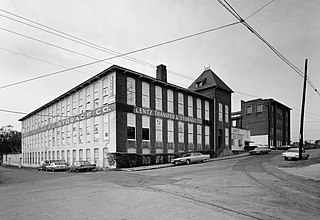
Arista Cotton Mill Complex, also known as Salem Cotton Manufacturing Company and Arista Cotton Mill and Lentz Transfer & Storage Co., is a historic cotton mill complex located at Winston-Salem, Forsyth County, North Carolina. The complex includes two buildings: a brick building built in 1836 by part of the Moravian congregation of Salem and the original home of the Salem Cotton Manufacturing Company, and the other is the original Arista Mill, built in 1880 by F. and H. Fries Cotton Arista Mills. The 1836 Salem Cotton Mill is a three-story, brick building with a monitor roof. The 1880 mill is a three-story brick building, 14 bays long, with bracketed eaves with timber supports. A two-story roughly triangular brick building was added about 1900. The 1836 building has been converted to a hotel known as The Historic Brookstown Inn.

Indera Mills, also known as Maline Mills, is a historic textile mill complex located at Winston-Salem, Forsyth County, North Carolina. The complex includes a two-story, gable roof brick building with a brick addition ; a small, one-story brick boiler room building ; and two flat-roof brick buildings built between 1907 and 1912 with their long sides contiguous. Indera Mills occupied the complex until 1998. The complex has been converted to commercial and residential use.
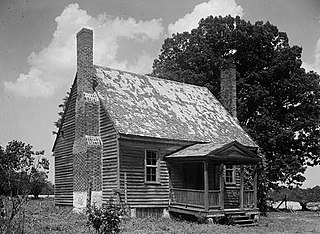
Cascine is a historic plantation complex and national historic district located near Louisburg, Franklin County, North Carolina. The district encompasses 12 contributing buildings, 4 contributing sites, and 3 contributing structures. The main house was built about 1850, and is a large two-story, Greek Revival style frame dwelling, in the manner of Jacob W. Holt, with Gothic Revival style influences. Also on the property is a small, one-story frame dwelling dated to about 1752. It was repaired and refurbished in the mid-20th century. Also on the property are the contributing brick kitchen, frame stable, granary, carriage house, family cemetery, slave cemetery, remains of slave quarters, tenant house, six log and frame tobacco barns, grist mill complex, and archaeological sites.

Laurel Mill and Col. Jordan Jones House is a historic home and grist mill located near Gupton, Franklin County, North Carolina. The house was built about 1850, and is a one-story Greek Revival / Italianate style frame cottage over a raised brick basement. The frame mill building is two stories tall supported by large stone piers. The mill building extends over Sandy Creek. The house and mill are all that remains of the ambitious local industrial complex.

The Bessemer City Downtown Historic District is a national historic district in Bessemer City, Gaston County, North Carolina. It encompasses 23 contributing buildings and 10 contributing structures in Bessemer City's central business district. The buildings were built between after 1896, and include one- and two-story commercial buildings and two large, sprawling textile mill complexes. Notable buildings include:

Oakdale Cotton Mill Village is a historic textile mill, mill village, and national historic district located at Jamestown, Guilford County, North Carolina, United States. The district encompasses 37 contributing buildings including the Logan Manufacturing Company complex built during the 1880s and 33 frame mill worker houses dated to the early-20th century. The factory complex consists of a three-story rectangular brick office, a one and two-story L-shaped brick factory with a four-story tower and five one-story brick warehouses, a small one-story board-and-batten blacksmith shop, and a polygonal brick smokestack.

Former Parks-Cramer Company Complex is a historic factory complex located at Charlotte, Mecklenburg County, North Carolina. The contributing resources are the Manufacturing Building; Shipping, Receiving, and Pipe Storage building; storage building; and rail spur line and they were developed between 1919 and 1955. The Manufacturing Building is divided into six sections, and is a large one-story brick building with a flat roof and stepped parapets It features banks of large, steel-sash factory windows. The Parks-Cramer facility was one of the region's foremost manufacturers of humidifiers and air-conditioning equipment for the new cotton mills.
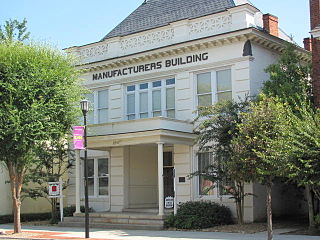
Manufacturers Building is a historic commercial building located at Rockingham, Richmond County, North Carolina. It was built about 1904, and is a two-story, red brick commercial building. It has a high hipped and slate covered roof. The building served as the administrative offices for five of the most important textile mills in Richmond County—Pee Dee Manufacturing Company, Steele's Mills, Roberdel Mills, Midway Mills, and Hannah Pickett Mills.

Spray Industrial Historic District is a national historic district located at Eden, Rockingham County, North Carolina. It encompasses 70 contributing buildings, 9 contributing structures, and 1 contributing object in an industrial section of the town of Eden. It includes buildings associated with eight textile mill complexes, mill village housing, and seven commercial buildings. Notable contributing resources include the Smith River Dam and Spray Power canal, Morehead Cotton Mill complex, "Superintendent's" House, Imperial Bank and Trust Company (1912), Leaksville Cotton Mills complex, Spray Mercantile Building, Spray Cotton Mills complex, Lily Mill complex, Nantucket Mills complex designed by R. C. Biberstein, American Warehouse Company complex, Rhode Island Mill complex, Phillips-Chatham House, and Spray Woolen Mill complex.
Shuping's Mill Complex was a historic grist mill complex located near Faith, Rowan County, North Carolina. The complex included a two-story frame dwelling, flour and corn mill building, cotton gin house (1895), and two other contributing buildings. The mill was built in 1900, and was a 2 1/2-story frame building sheathed n weatherboard and on a stone foundation. It was destroyed in 1986 when a car crash sparked a fire. The original boiler still remains on the property.
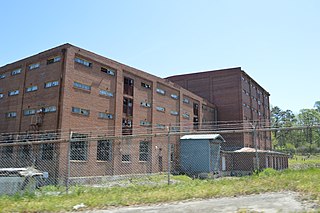
The Proximity Print Works, also known as Cone Finishing Plant, is a historic textile mill complex located at Greensboro, Guilford County, North Carolina. The complex includes nine contributing buildings, two contributing structures, and one contributing object. It is a large, brick, roughly rectangular collection of industrial buildings constructed in multiple stages beginning in 1913. It is notable as the first textile printery in the South. The mill remained in operation until 1977.

The Pickett Cotton Mills is a historic industrial property at 1200 Redding Drive in southwestern High Point, North Carolina. The mill complex includes the original 1911 two-story brick-and-concrete mill building, a storage warehouse, office building, and sprinkler house. The Pickett Cotton Mill Company was founded in 1910, and was the first successful textile operation in the city. The mill was closed in 1985 due to stiff foreign competition. The main mill is an exemplary instance of sturdy, high-quality construction of the period, and the office building, which is also typical of the period, is one of the few to survive.























